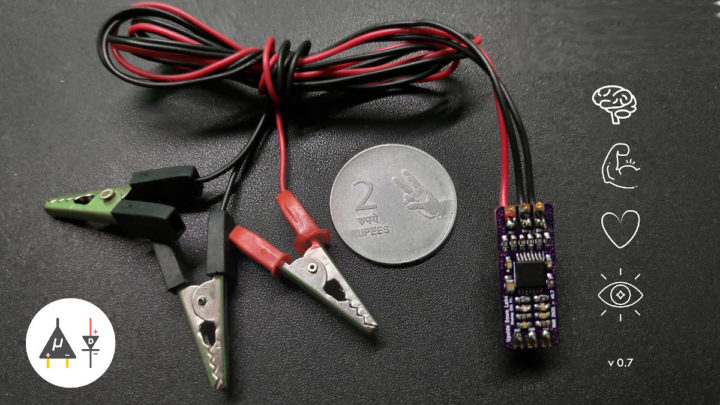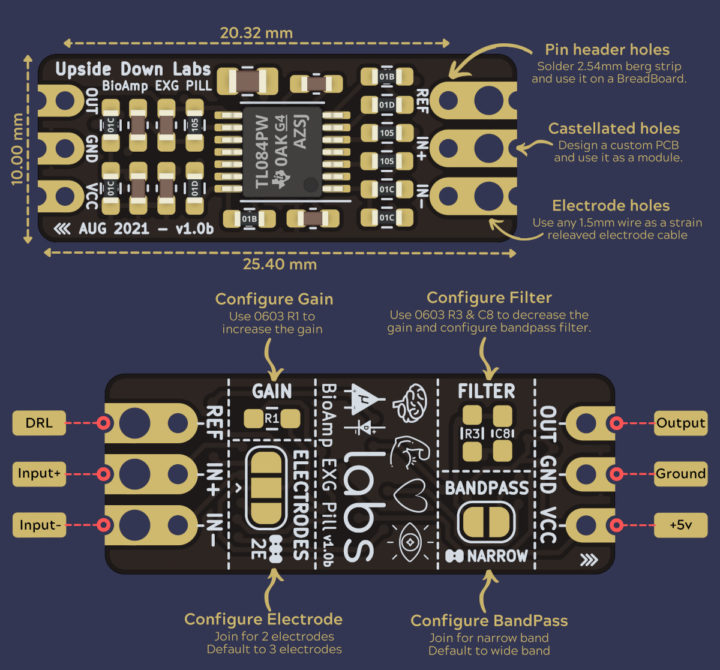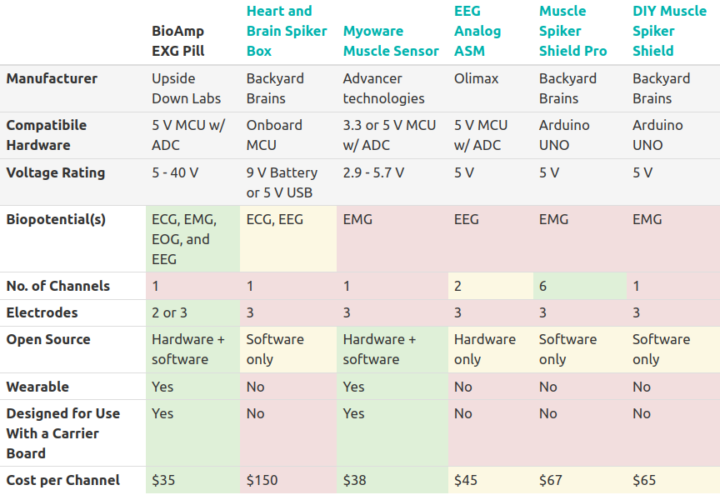BioAmp EXG Pill is a small Analog Front End (AFE) biopotential signal-acquisition board designed to be interfaced to any 5V MCU board with an analog-to-digital converter (ADC) such as most Arduino boards, or through a dedicated 5V ADC like the Texas Instruments ADS1115.
The board can record biopotential signals like ECG (electrocardiogram), EMG (electromyography), EOG (electrooculography), and EEG (electroencephalogram), or in more simple terms, biosignals from the heart, muscles, eyes, or brain activity.
BioAmp EXG Pill key features and specifications:
- Compatible with any 5V MCU with an ADC
- Biopotentials: ECG, EOG, EMG, and EEG (configurable)
- No. of channels: 1
- Electrodes: 2 or 3 (configurable)
- Input Voltage – 5 – 40 V
- Input Impedance: > 35 MΩ
- Dimensions – 25.4 x 10 mm
- OSHWA certifications – IN000026
The board is open-source hardware and you’ll find KiCAD hardware design files like schematics and Gerber files on Github where you’ll also find several Arduino code samples for ECG, EMG, EOG, EEG, including one controlling a servo to open/close a 2-finger hand using EMG (muscle) data, and others blinking an LED following either your heartbeat or eye blinking.
BioAmp EXG Pill is not the first hardware use to monitor biosensing data or vital signs with Arduino or Raspberry Pi boards, and we previously covered HackEEG Arduino shield for EEG, EMG, EKG, the ESP32-based E3K wireless bio-sensing platform, as well as HealthyPi v4 HAT for Raspberry Pi (ECG, SPO, body temperature). There are many other as shown in the comparison table below.
Upside Down Labs has just launched the board on Crowd Supply with a symbolic $1 funding goal. There are two main rewards with the $69 “BioAmp EXG Pill Explorer Pack” including two BioAmp EXG Pill boards, 15 gel electrodes, some pin headers, six alligator clips, and two 1.5 mm electrode cables, as well as the $249 “BioAmp EXG Pill Neuroscience Ninja Pack” with eight boards, 100 gel electrodes, plenty of headers, 24 alligator clips, and eight 1.5 mm electrode cables. Shipping adds $8 to the US, and $18 to the rest of the world with deliveries scheduled to start at the end of February 2022.

Jean-Luc started CNX Software in 2010 as a part-time endeavor, before quitting his job as a software engineering manager, and starting to write daily news, and reviews full time later in 2011.
Support CNX Software! Donate via cryptocurrencies, become a Patron on Patreon, or purchase goods on Amazon or Aliexpress








Those nipple clips look extremely painful…
Hm? Looks like a regular 4x opamp chip and a few passives. Am I missing something? It’s not even some special low-noise low-offset kind.
How’s this $35?
Anyway, OTOH, if biosignals capture is this easy, I have a breadboard project for next weekend. 🙂
Yes. Supposed medical grade means something, it should be comply with various study requirements. Its not crazy like 100 thousand dollars, and its beats the competition. Used to be you’d need FDA clearance, which could take years and mountains of paperwork given that bureaucracy. But I’m not expert about the what is required to FDA clear and what isn’t.
“simple” eeg clips can be hundreds of dollars. yes, ones you’d just toss if they weren’t working. At any rate, given how simple yet revolutionary, it invites race to the price bottom if you willing to wait.
kewl, seems medical hacking getting traction. As for the alligator clips, I think those connect to a 2nd pair of wires — like old school long wire disc sensors, no, they aren’t body clamps, much less nipple clamps, haha. i dunno how would sensors attach to the eyes. o.O Anyone know?